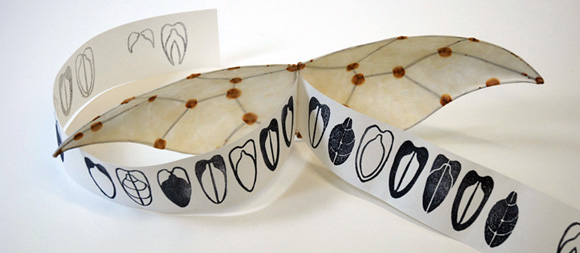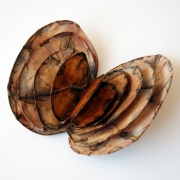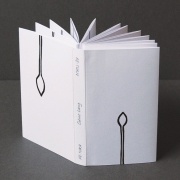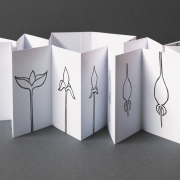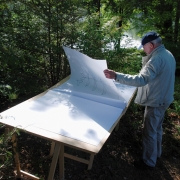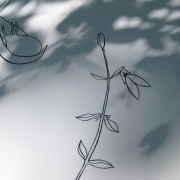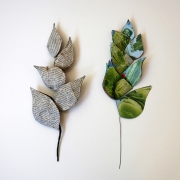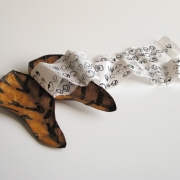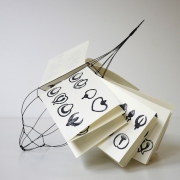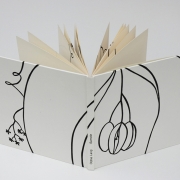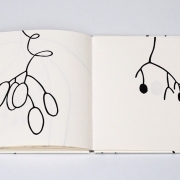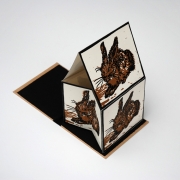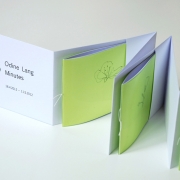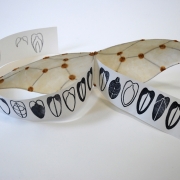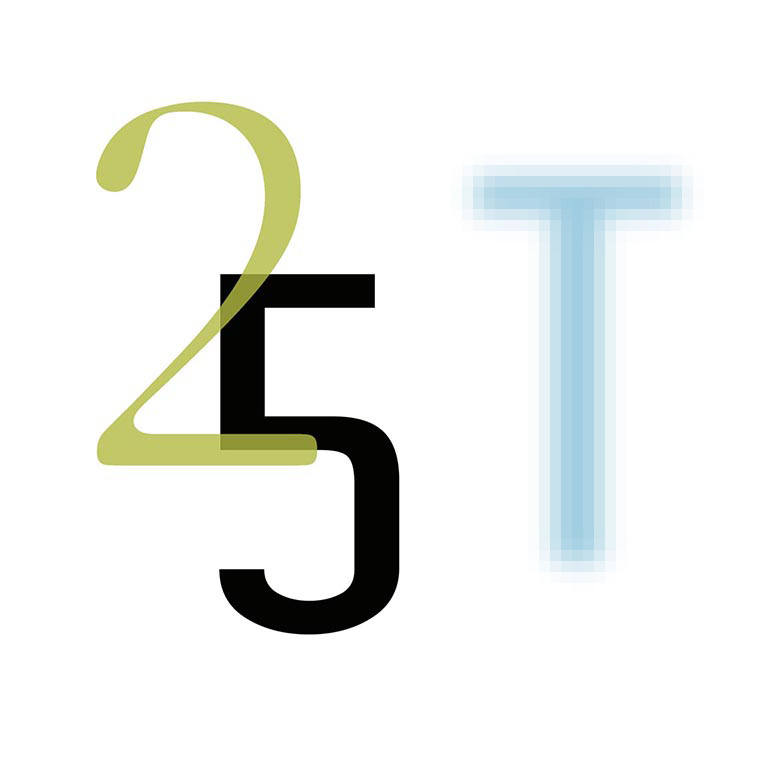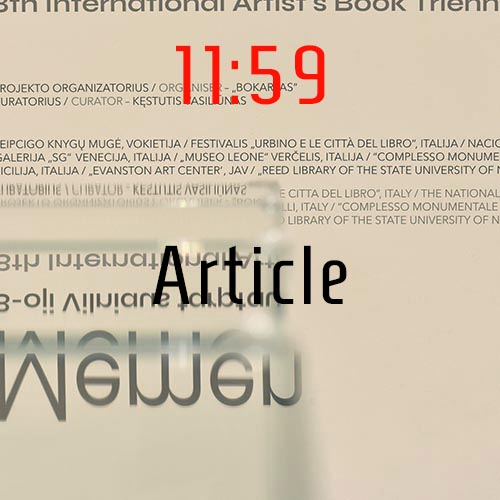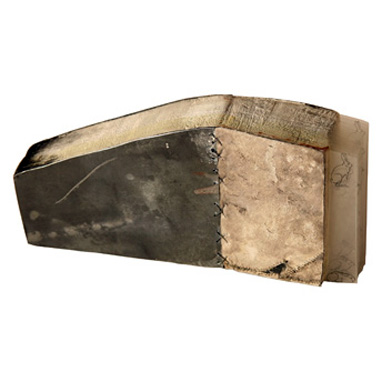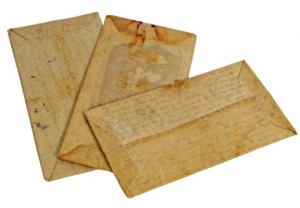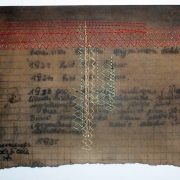Odine Lang “Experimental Bookarts”
Time: 17 September – 10 October 2013
Odine Lang, a “master of silence”, in the Virtual Gallery.
An artist Odine Lang from Aachen, Germany create fantastic book objects. Her artist’s books are three dimensions sculptures with strong structure. I could say, that books, made by Odine are very “green”. It is books, inspired by nature, are natural and minimalistic. In the books she connect different materials like metal wire and Japanese paper, white natural paper and black ink.
In our noisy era it is so nice to see Books of Silent.
Kestutis Vasiliunas
Curator of the Virtual Gallery
1 | ‘Closure’. Book object. Wire, Japanese paper, tea, shellac, bookbinding thread. 10 x 7.5 x 3.5 cm. Unique book. 2009.
‘Closure’ is a book object, resembling seashells, insect wings, or petals. Each pair of pages encloses a smaller pair. There are five layers of “shells” to open until you reach the centre. The smallest “shell” is well protected by the closed larger ones.
2 | ‘Zeit’. Book object. Wire, Japanese paper, shellac, rubber stamps, book-binding thread. Cover: 19 x 10 cm, paper banner: 7 x 65 x 5.8 cm. Unique book. 2010.
‘Zeit’ (‘Time’) is a book object with an enclosed poem. Its cover, resembling shells, contains a paper banner with a codified text, printed with hand-cut rubber stamps. The code, a series of organic forms, as well as the text deal with growth and harmony within nature.
3+4 | ‘Re:turn’. Concertina fold book with 24 pages, the first and last page are connected at the back. Linocuts, hand made prints with offset printing ink. 14 x 7.8 x 1.2 cm. Edition: 5 copies. 2008.
‘Re:turn’ shows the development of a plant-like figure. A small “bud” grows bigger into a kind of “seed”, retracting the “flower stalk”, and then growing as a new appendix at the top of the book. You can turn the book upside down, and reread from the back to the front. In both directions the book begins with the same figure.
5+6 | ‘Hortus Duriensis’. Book installation. Tarpaulin, tarpaulin colour, thread stitching, wooden box, Trestle table legs. Book: 90 x 90 cm x 3.5 cm. 20 pages. Unique book. 2012. Installation view: Parkraum Düren, Germany, May 2013.
This large-scale book is designed for outdoor presentation. It contains brush drawings reminiscent of scientific illustrations in Biology textbooks. A developing cycle can be followed in its different stages. A plant grows from a seed. Its fruits, like jellyfish come alive, giving birth to insect-like forms, which in turn populate the plant – all is one.
7 | ‘Crop I’. Book object. Wire, Japanese paper, newspaper, Chinese ink. 29.5 x 10 x 2.4 cm. Unique book. 2011.
‘Crop II’. Book object. Wire, re-used advertising flyers, bookbinding thread. 31.5 x 10.5 cm. Unique book. 2011.
‘Crop II’ looks like an ear of wheat. Seven booklets, shaped like grains, are sewn on to a wire blade. ‘Crop II’ is made from supermarket flyers advertising vegetables and fruits. In modern life we harvest our crops (groceries) not from the fields but from the shops. The shape of ‘Crop I’ is also reminiscent of an ear of wheat. The object is covered with a newspaper article about bio-economy. Key words indicate the use of food crops for energy production, patent-registered plants, and the limitations of arable land.
8 | ‘Cor’. Book object. Wire, Japanese paper, shellac, bookbinding thread. 18 x 13.5 x 5.5 cm. Unique book. 2010.
‘Cor’ (‘heart’) is a book object consisting of four pairs of “shells” that are bound like a book, and can also be opened like a book. One cover hides a smaller one. “To open one’s heart” implies a very intimate kind of communication.
9 | ‘Secrets’. Book object. Wire, Japanese paper, tea, shellac, Chinese paper, rubber stamps, bookbinding thread. Cover: 26 x 12 x 4.5 cm, paper banner: 9 x 105 cm. Unique book. 2008.
‘Secrets’ contains a text banner with a codified text, written with an alphabet of vegetable forms: a secret, one that is well hidden by both the cover and the encryption.
10 | ‘Metamorphosis of Plants’. Book object. Wire, rubber stamp prints on paper. 28 pages. Height: 20 cm. Unique book. 2010.
The ‘Metamorphosis of Plants’ is a movable book object – it has no cover, and cannot be closed like a traditional book. Its centre – shaped like a spinning top – is a wire construction. Fixed on the bars are seven booklets with signs stamped on them. These signs are cryptic letters from an alphabet of forms, representing the first verses of a poem by Goethe. In ‘The Metamorphosis of Plants’ Goethe describes the growth of plants as a general movement. The cryptograph with its plant forms shows an ornamental interpretation of the poem’s subject matter.
11 | ‘Plant Diary’. ‘21-2-2011’. Booklet with pencil drawings. Transparent paper, Clematis stalk. 22.5 x 15.5 x 4.5 cm. 12 pages. Unique book. 2011.
12 | ‘Plant Diary’ ‘22-2-2011’. Leporello with pencil drawings. Drawing paper, Iris stalk. 5 pages. 34.5 x 8.8 x 1 cm. Unique book. 2011.
The Plant-Diaries are artist’s book “finger exercises”, each produced in a day. Each book is dedicated to one plant; it includes pencil drawings of the plant and plant materials, used as experimental forms of bookbinding.
13+14 | ‘Semele’. Codex. Linocuts, hand made prints with offset printing ink on book paper, title with metal type, hand bookbinding. 20.8 x 21 x 1 cm. Edition: 7 copies. 2011-2013.
‘Semele’ demonstrates the fictitious growth of a vine-like plant in a sequence of 20 linocuts: Germination, blossoming, ripening… a seemingly natural development, but as depicted here, impossible in nature. In Greek mythology “Semele” is the mother of Dionysius, god of wine, who was born unnaturally.
15 | ‘Hase und Haus’ (‘Rabbit and House’). Linocut book object. 15.8 x 16.4 x 0.9 cm. Edition: 3 copies. 2006.
Contribution to the 4th International Artist’s Book Triennial Vilnius 2006.
16-17 | ‘8 Minutes’. 8 booklets, each with 8 pencil drawings, with green plastic sheet cover, and each book pocketed into a folded leporello. 8.3 x 11.7 x 3 cm. Single booklets: 7.4 x 10.5 cm. Unique book. 2012.
The Leporello with pockets contains eight booklets each with eight pencil drawings. Each drawing was made in exactly one minute. They are observational, performed by focusing on plant details. Each booklet shows one plant, each drawing a different fragment of the plant. After 60 seconds, the time for drawing stops, all that is shown is what was actually observed and recorded during this period.
18+19 | ‘Spinifera’. Book object. Wire, Japanese Paper, bookbinding thread. 23 x 15.2 x 1.3 cm. 16 pages. Unique book. 2013.
‘Spinifera’ (‘the one bearing spines’) consists of double pages bound like a book. Unlike normal books these pages consist of paper glued over a wire framework with protruding pointed spikes. On the pages, the rust from the wire structure leaks through the paper giving the appearance of drawings. The book can be displayed open, standing on the wire spikes, thus becoming a three-dimensional object. The binding threads (“spring action”) act as dividers, allowing the pages to open easily and with the same distance between one and another.
20 | ‘Sanfter Flügel’. Book object. Wire, Japanese paper, shellac, rubber stamps, bookbinding thread. Cover: 17.3 x 9.7 x 4 cm, paper banner: 5.3 x 79 cm. Unique book. 2011.
‘Sanfter Flügel’ (‘Gentle wing’) belongs to a small series of book objects with wing-shaped covers made of wire and paper. They enclose a longer paper banner with stamped characters. These characters originate from an alphabet of forms derived from the shape of a cuttlefish bone (sepia). The encoded text is: “Where your gentle wing rests”. This quote is from Friedrich Schiller’s “Ode to Joy”, in which he formulates his vision: All people “become brothers”, where the “gentle wing” of joy “rests”. The composer Ludwig van Beethoven translated this text into his ninth Symphony, which today remains the melody of the European anthem. There are some similarities in the variations of the books where the text is translated into different European languages: ‘Sanfter Flügel’ in German, ‘Zachte Vleughel’ in Dutch.
